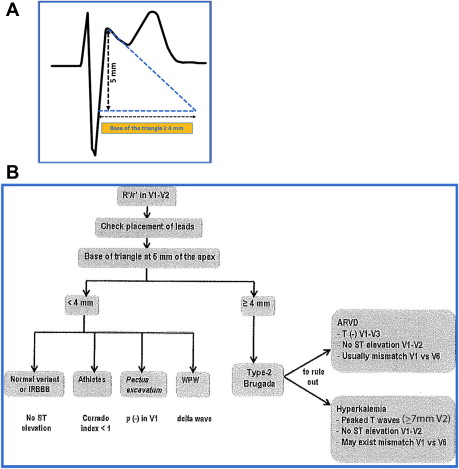We have read the report by Zorzi et al on differentiating the dome-like ST elevation pattern with negative T wave recorded in highly trained athletes from patients with type 1 Brugada syndrome (BS).
We recently published a consensus document containing a number of points that help in the differential diagnosis between the BS electrocardiographic pattern and other patterns presenting ST elevation and/or R′ in leads V 1 and V 2 . Although the report by Zorzi et al is of great interest in this regard, there are certain aspects that we would like to clarify:
- 1.
The investigators determined the point of maximum ascent in the type 1 BS pattern as the J point, but we know that sometimes this is not so because the J point can in certain cases be observed somewhat after the high takeoff. However, in BS, the ST segment slopes downward, so the ratio STJ/ST 80 ms is >1, as the investigators well conclude in their report. Therefore, to exactly measure where the QRS ends in leads V 1 and V 2 , it is not useful to measure from the beginning of the QRS to the high takeoff. This is important because there may be a difference (“mismatch”) between the duration of the QRS in leads V 1 and V 2 with respect to leads V 5 and V 6 (as stated in the consensus mentioned previously).
- 2.
The investigators only included in their study athletes with domed-type morphology followed by a negative T wave in leads V 1 to V 3 . However, a significant number of elite athletes show R′ in leads V 1 /V 2 where the differential diagnosis with type 2 BS pattern should be made. We recently published a new diagnostic criterion which is very useful in clinical practice called “base of the triangle” ( Figure 1 ). This is easily measurable and has high sensitivity (82%) and specificity (92.1%) for the recognition of BS pattern. A recent publication from our group also proposes an algorithm to differentiate electrocardiographic patterns presenting with R′ in leads V 1 /V 2 . We believe this simple algorithm may help physicians to differentiate normal from abnormal conditions presenting with this specific pattern ( Figure 1 ).





